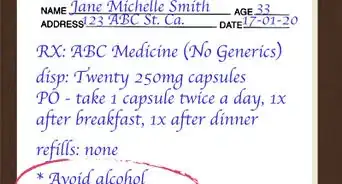This article was medically reviewed by Sarah Gehrke, RN, MS. Sarah Gehrke is a Registered Nurse and Licensed Massage Therapist in Texas. Sarah has over 10 years of experience teaching and practicing phlebotomy and intravenous (IV) therapy using physical, psychological, and emotional support. She received her Massage Therapist License from the Amarillo Massage Therapy Institute in 2008 and a M.S. in Nursing from the University of Phoenix in 2013.
There are 8 references cited in this article, which can be found at the bottom of the page.
This article has been viewed 29,698 times.
Misoprostol is a prescription medication that is frequently given to patients taking non-steroidal anti-inflammatory drugs (NSAIDs) as a way to prevent gastric ulcers.[1] It will typically be taken for as long as a patient's NSAID treatment lasts. Take Misoprostol with food or milk, 4 times a day as recommended by your doctor. Contact your doctor immediately if you experience any serious side effects or symptoms while taking this medication. In some cases, Misoprostol is also used to treat miscarriages as an alternative to surgery.
Steps
Taking Misoprostol to Prevent Ulcers
-
1Read the directions carefully. Misoprostol pills come in different concentrations so it is important to read the dosage information on the package or bottle before taking them. Depending on the strength of the dosage, you might have to take 2 pills at a time or cut pills in half for each dosage. Take note of the concentration and the number of pills you have to take during the day.[2]
-
2Take 200 mg of Misoprostol four times a day if you're an adult. The usual dose for adults is 200 mg 4 times a day, unless your doctor recommends a lower dosage. Take the pills at mealtimes to maintain a regular schedule. Take the last pill of the day right before you go to bed.[3]
- Misoprostol should only be taken by adults, as the safety and effectiveness of the drug on children has not yet been established.
Advertisement -
3Take Misoprostol with food or milk. Diarrhea is a common side effect of Misoprostol, but the chances of it happening are significantly reduced if you take the drug with food or milk. Time your doses so that they line up with breakfast, lunch, and supper. Have a small snack or a glass of milk with your last pill of the day.[4]
-
4Take a missed dose as soon as possible and stay on schedule. If there is more than an hour to go before your next dose, take a missed dose as soon as you remember. If you don't remember until it's almost time for your next dose, skip the missed one and continue with your regular schedule. Do not double your next dose to make up for a missed one.[5]
-
5Take the drug on the 2nd or 3rd day of your period if you are a woman. Given the danger this medication could pose to a fetus, if you are of childbearing age, your doctor will likely instruct you to wait until the 2nd or 3rd day of your period to start the drug. They may also ask you to take a pregnancy test before they write you a prescription.[6]
- If you are a woman, don't take this medication unless you meet the following conditions:
- You tested negative for pregnancy in the 2 weeks prior to using it.
- You are using an effective birth control to prevent pregnancy.
- You've received a notice of the risks of using Misoprostol if you're of childbearing age, as well as possible birth defects.
- You start taking Misoprostol only on the 2nd or 3rd day of your next period.
- If you are a woman, don't take this medication unless you meet the following conditions:
Using Caution When Taking Misoprostol
-
1Take the medication directly as ordered by your doctor. Your doctor will be able to decide if Misoprostol is right for you based on your overall health, medical history, and current prescriptions, if any. They will also be able to establish the right dosage of the medication for you. Follow your doctor's instructions for taking Misoprostol exactly and do not change how you take the drug without their approval.[7]
-
2Inform your doctor of any non-prescription drugs that you are taking. Non-prescription drugs can interfere with Misoprostol or exacerbate the symptoms associated with it. Tell your doctor about any over-the-counter drugs you are taking, as well as any natural supplements or vitamins. If you are already taking Misoprostol and want to start taking a new, non-prescription drug, ask your doctor first.[8]
- For instance, antacids that contain magnesium can raise your risk for diarrhea, or make it worse.
-
3Use birth control if you are able to get pregnant while taking Misoprostol. Misoprostol is a strong medication that can cause miscarriage, premature birth, and birth defects if taken when pregnant.To avoid pregnancy, use a reliable form of birth control such as condoms or birth control pills while you are taking Misoprostol. If you are taking Misoprostol and think you might be pregnant, contact your doctor right away.[9]
-
4Talk to your doctor about using Misoprostol to accelerate a miscarriage. Misoprostol is sometimes used to accelerate a first trimester miscarriage as an alternative to surgical measures. In this scenario, Misoprostol is inserted vaginally or melted under the tongue to soften and relax the cervix. Speak to your doctor about this option, which is still an "off-label" use of the drug.[10]
- Do not use Misoprostol this way without permission and guidance from your doctor.
-
5Contact your doctor about serious side effects. Some side effects of Misoprostol, such as diarrhea or upset stomach, are mild and common during the first few days on the medication. Other symptoms are more serious and should be disclosed to your doctor right away. Tell your physician if you experience:[11]
- abdominal pain
- convulsions
- difficulty breathing
- low blood pressure
- severe diarrhea
- fever
- tremors
- drowsiness
-
6Contact emergency medical services if you suspect an overdose. If you exceed your recommended dose of Misoprostol and fear for your health, do not wait to seek help. Call the poison control hotline for your region and and communicate as clearly as you can what drug took, how much you took, and when you took it. You can also contact emergency services for immediate medical care.[12]
- As a precaution, keep the number for poison control near your telephone in case of emergency.
Warnings
- Do not, under any circumstances, give this drug to a friend who also suffers from gastric ulcers. There is always a risk that they may be pregnant.⧼thumbs_response⧽
References
- ↑ https://www.drugs.com/mtm/misoprostol.html
- ↑ https://www.drugs.com/pro/misoprostol.html
- ↑ https://www.drugs.com/dosage/misoprostol.html
- ↑ http://www.medbroadcast.com/drug/getdrug/misoprostol-by-aa-pharma
- ↑ http://www.medbroadcast.com/drug/getdrug/misoprostol-by-aa-pharma
- ↑ https://www.drugs.com/pro/misoprostol.html
- ↑ http://www.medbroadcast.com/drug/getdrug/misoprostol-by-aa-pharma
- ↑ https://www.drugs.com/cdi/cytotec.html
- ↑ https://www.drugs.com/cdi/cytotec.html
About This Article
To take Misoprostol, make sure you follow your doctor’s directions, which will usually be to take 200 milligrams 4 times a day if you’re an adult. Take the tablets during each meal and right before bed so you don’t forget. However, if you do miss a tablet, you can take it up to 1 hour before your next dose. It’s best to ingest your tablets with food or milk to reduce the risk of diarrhea. If you notice any serious side effects, like abdominal pain, difficulty breathing, fever, tremors, or drowsiness, contact your doctor as soon as possible. You should also inform you doctor if you’re pregnant, since Misoprostol can harm the fetus. For more tips from our Medical co-author, including how to use Misoprostol to accelerate a miscarriage, read on!
















-Step-17-Version-3.webp)


-Step-23.webp)



















































Medical Disclaimer
The content of this article is not intended to be a substitute for professional medical advice, examination, diagnosis, or treatment. You should always contact your doctor or other qualified healthcare professional before starting, changing, or stopping any kind of health treatment.
Read More...